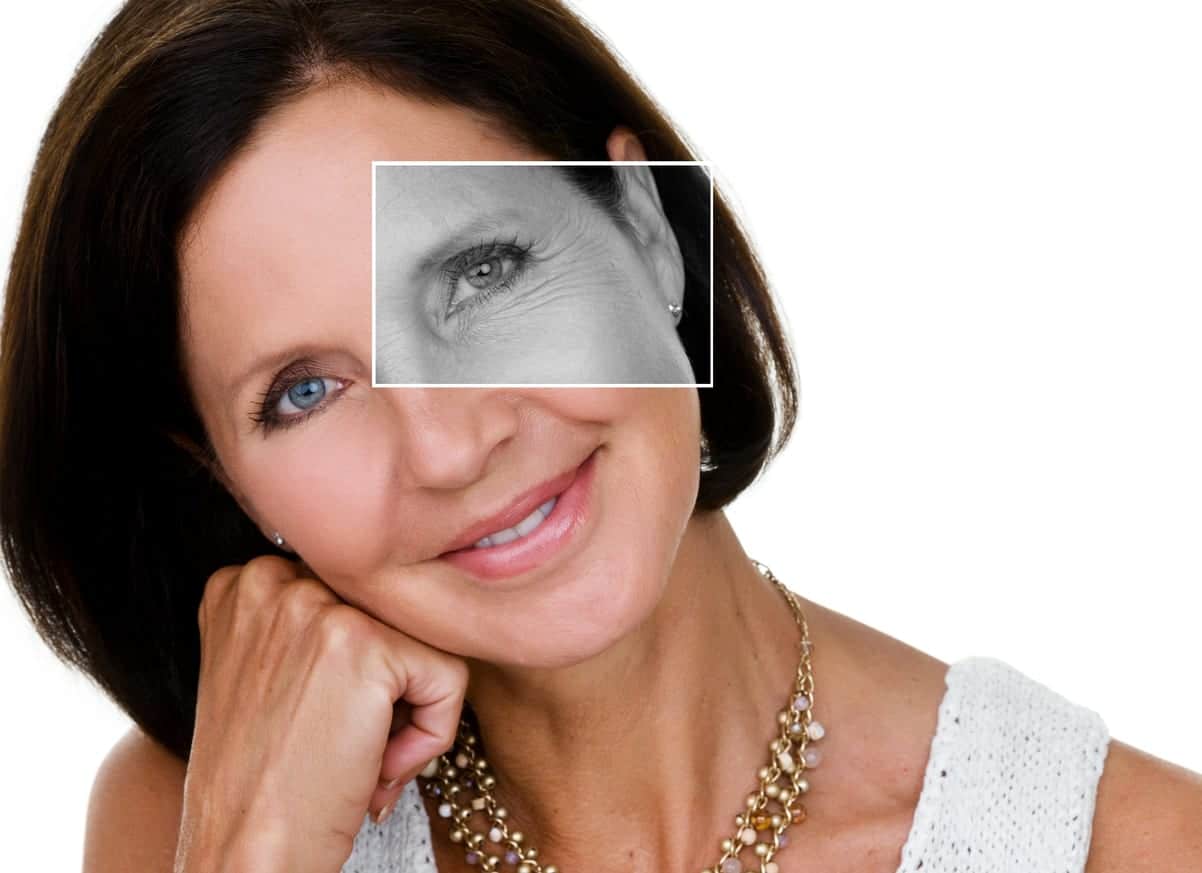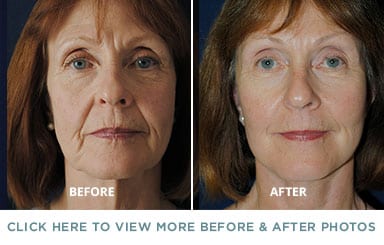
Read what our patients are saying!
“When I looked for my surgeon, I specifically looked by reputation and outcomes, and once I met with Dr. Watterson there was no doubt that I had chosen correctly. He took the time to answer any questions that I had and I was completely comfortable day of surgery. He is so in tune with you and what you want. There isn’t anyone I would recommend over Dr. Watterson. The outcomes were even better than I had ever anticipated.”
–Michelle
What Is A Facelift?
Modern medicine keeps lengthening our life expectancies. Unfortunately, our skin can’t keep up. That’s especially true in the high altitude of Utah, where the UV rays are stronger and humidity is low. Plus, there are so many reasons to be outside having fun, which exposes our skin, especially on our face, to even more sun, wind, and other environmental factors.
That’s the perfect recipe for the development of deep creases beside the mouth, hanging jowls, sunken cheeks, loose skin and fat deposits on the neck, and an overall loose, saggy look.
A facelift with Dr. Paul Watterson can set back the clock in the aging process. A facelift, also referred to as a Rhytidectomy, removes loose skin on your face and neck, tightens the underlying muscles and tissue, and removes excess fat. Facelifts can take 10 to 15 years off your face and are excellent procedures for both women and men. Dr. Watterson is proud to offer Facelifts to patients in Salt Lake City, Draper, UT and all across the Wasatch Front!
Facelift vs. facial fillers
Facelifts make permanent changes that endure. Of course, you will still age, but your face will age from a place that is 10-15 years younger than it was before your facelift. This is an important point that many are not aware of. As mentioned above, many of Dr. Watterson’s patients have a second, less involved procedure in 5-10 years to maintain their results. But the changes made are permanent.
You’ve probably heard the “liquid facelift” touted in promotional materials from other practices. These procedures use dermal fillers and Botox to erase wrinkles and to add volume to sagging, depressed areas. These are valid procedures if you do not want to have surgery. But the results are not as dramatic, and your results will only last about one year. To maintain your results, you’ll need to have another injection session at that point. Importantly, the costs can be dramatically higher.
What Types Of Facelifts Does Dr. Watterson Offer?
The facelift is thought to be the original cosmetic surgery procedure, first performed in Berlin in 1901. Until around two decades ago, most of these procedures would be what is known today as a “traditional” facelift. But these methods often left the patient with a stretched appearance, as the skin was the focus of the procedure.
Today, Dr. Watterson pays more attention to the underlying musculature and support tissues, lifting and bringing them back to their former higher position. This creates a more natural-looking rejuvenation. There are now a variety of different methods that Dr. Watterson uses for these procedures. He tailors every surgery to the individual situation of the patient. He may use a combination of methods. These are some of the common methods used:
Traditional Facelift
A full facelift seeks to provide the most rejuvenation across the mid-face down through the neck. A full facelift involves lifting and repositioning the deeper tissues in the face and removing certain attachments. Fat is sculpted (Dr. Watterson avoids removing too much fat to avoid creating a “hollow” look). Excess skin is trimmed and then re-draped.
The incisions with a traditional lift start at the temples, run downward in front of the ear, wrap around the earlobe, and terminate in the hairline of the lower scalp. If the patient has particular issues in the neck area, a second incision is made under the chin to lift, tighten, and trim excess skin on the upper neck.
Limited-Incision Facelift
The goals of this facelift aren’t as widespread, instead providing limited rejuvenation around the eyes and mouth, including nasolabial folds and other deep creases. Shorter incisions are made at the temples, around the ears, and, if needed, in the lower eyelids and/or under the upper lip.
Mid-Face Lift
Volume loss in the cheeks is a common concern with many patients, and the mid-face lift targets those areas. Mid-face lifts can remove sagging in the cheeks, reduce puffiness under the eyes, and correct nasolabial folds. Incisions are small, usually in the lower eyelids or mouth.
Neck Lift
While not technically a “facelift,” neck lifts are often part of these procedures. After all, who wants a renewed face, only to have a sagging neck full of neck banding? The neck lift concentrates on jowls and fat under the chin. The incision is made around the earlobe and behind the ear to the lower scalp. An incision can also be made under the chin.
Who Are The Ideal Candidates For Facelift Surgery?

Reality is, many people living in Utah over the age of 45 could probably benefit from a facelift with Dr. Watterson. It’s a simple fact of natural aging, combined with our outdoor lifestyles here in the Mountain West. Clinically known as rhytidectomy, a facelift rejuvenates the mid-to-lower face and neck. If any of these characteristics sound like what is going on with your face, a consult with Dr. Watterson would be a great idea:
- You have mid-face sagging
- You have deep creases under your eyes
- You have deep nasolabial folds
Jowls have formed on your jawline - You have fatty, sagging areas just below your cheekbones
- You have loose skin, wrinkles, vertical cords, and fatty tissue on your neck
What Results Can I Expect From A Facelift? How Long They Will They Last?
The changes made by Dr. Watterson are permanent. Elevating your underlying tissues will keep your facial sagging to a minimum. Obviously, any skin removed is gone for good. You’ll have to be patient with swelling to see your final results, but within a few weeks, you’ll love how your face looks.
Of course, Dr. Watterson, while being an accomplished surgeon, can’t do much about the march of time. Your facial skin and underlying tissue will continue to age.
Declining collagen production and slackening of muscle and tissue is a fact of life. Still, your face will continue to age but it will do that from a much younger starting position, thanks to the changes made with your facelift.

You’ll enjoy your results for the rest of your life. Some of our patients opt to have another smaller procedure, such as a minimal incision facelift, in five to 10 years to keep up with the aging process.
How Long Does the Facelift Procedure Take?
A few different factors are involved in determining the length of your facelift procedure. One is the type of facelift the doctor will perform. Limited incision facelifts and mid-face lifts may take less time than a traditional facelift or combination of procedures. On average, the surgery can take between two and five hours. You can expect to be fully informed about all aspects of your surgery after our thorough consultation.
How Can I Prepare for a Facelift?
There are several ways that you can prepare for your facelift so that you achieve the best possible outcome.
Before your consultation:
- Write down all of the questions that come to mind
- Write down pertinent information that will help us evaluate your medical history
- Write down all medications and supplements you take
- Stop smoking
After your consultation:
- Arrange adequate time off from work and other obligations
- Arrange to have someone bring you to the surgery center and pick you up after your procedure
- Arrange to have help around the house as needed for at least a few days
- Pick up your prescriptions and necessary medical supplies such as ice packs
- As outlined in your pre-operative instructions, stop taking medications that thin the blood
- Set up a comfortable recovery area at home that includes a recliner or extra pillows, extra blankets, and entertainment
Is There Anything I Should Avoid After Facelift Surgery?
You will receive detailed post-operative instructions to follow after your facelift procedure. General guidelines include when to shower, when to take medications, and what to avoid. To ensure the best possible outcome from facelift surgery, you should avoid too much physical activity for several days after surgery. Walking is necessary to avoid the formation of blood clots, but, beyond a few gentle walks around the house each day, your objective in recovery is to rest. As your incisions are healing, you should avoid wearing makeup and using your normal skincare products. You also should not color your hair for at least four weeks after your surgery. When you do begin going outdoors after your facelift, wear broad-spectrum SPF 30 sunscreen and a wide-brimmed hat. If you quit smoking before your facelift, continue the avoidance of this habit. Also continue avoiding medications and supplements that thin the blood.
What Kind Of Anesthesia Is Used?
Facelift surgeries may be performed using general anesthesia or IV anesthesia. General anesthesia places the patient into a state of controlled unconsciousness. IV sedation is a form of conscious sedation in which the patient is more aware of their surroundings but in a controlled level of "twilight sleep." Both forms of anesthesia are safe and effective. Both involve the constant oversight of a board-certified anesthesiologist. Under either form of anesthesia, patients do not feel pain.
Is A Facelift Painful?
No. Facelift procedures are performed with the utmost care and always include appropriate anesthesia. There are several medications and a few ways in which anesthesia may be administered. Each, however, works by inhibiting the signaling that normally occurs between the brain and body. As a result of this interruption in neurotransmission, the brain does not register sensations of pain. Depending on the type of anesthesia used, the patient is completely unaware of time, sounds, smells, and other stimuli during surgery.
What Is The Recovery From Facelift Surgery?
A facelift, as the name implies, adjusts large areas of skin and underlying muscles and support tissue. This creates tissue trauma, which leads to bruising and swelling.

After your surgery, your face will be bandaged and you will likely have some drainage tubes. There will be minimal bruising and some swelling that will last from two to three weeks. The first few days are the hardest, but then you will feel better quickly. Your skin may feel tight in the face and neck.
You will likely have numbness in areas, as well. This is normal and can last up to a couple months, as the sensory nerves adjust to the re-draped skin. Most patients can return to work by the third week.
Facelift recovery is interesting because at first you can feel elated and high and then two days later wonder why did I do this. This is a very normal experience and part of the hormonal changes that occur with surgery. But the outcome is extremely satisfying, and recovery is fast.
What Are The Risks Involved With A Facelift
Of course, all of the risks that accompany any surgery apply to facelift surgery, but there are some specific potential side effects:
- Injury to the nerves that control facial muscles (usually temporary)
- Numbness or tingling around the incision areas (temporary)
- Hair loss at the incision sites
- Skin discoloration (rare but can continue for several months)
- Skin healing issues (more common with smokers)
“I had a great experience with Dr Watterson. From the consultation, Pre-op to actual procedure. He had me fully prepared and informed. I came out of my surgery without any complications and had a normal recovery. I am very happy with my transformation. Would highly recommend Dr Watterson to anyone. His professionalism and work ethic is impeccable.”
–Nira M.
Does A Facelift Leave Scars?
Dr. Watterson uses his extensive experience and knowledge of facial anatomy to hide your incisions in the hairline and behind the ears. Initially, these scars will be pink, but after a few months they will gradually turn white and become far less noticeable.
Can I Combine A Facelift With Other Procedures From Dr. Watterson?
Some patients are confused by the term “facelift.” They assume it reverses aging on the entire face, hence the name. However, a facelift actually only targets the mid-face down through the upper neck. Different muscles are involved in the forehead area and the lower neck. So, if you want more widespread rejuvenation, many of Dr. Watterson’s patients have a forehead lift and/or a neck lift done in coordination with their facelift. Other patients address their eyes with blepharoplasty.
Schedule Your Facelift Consultation Today!
Interested in booking your Facelift in Salt Lake City, UT? Schedule an appointment today by calling us at 801-571-2020 or filling out our contact form.


